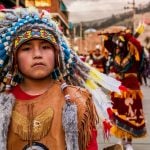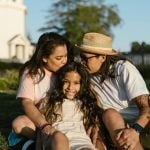Northwest Coast Masks (Photo Diary)
The Northwest Coast culture area stretches along the Pacific coast between the Cascade Mountains and the ocean. It extends north of California to Alaska. This is an area which is the home to many Indian nations who traditionally based their economy on the use of sea coast and river ecological resources. The Northwest Coast culture area stretches from the Tlingit homelands in Alaska to the Tolowa homelands in northern California.
 The shaded area on the map shown above shows the Northwest Coast culture area. This map is displayed in the Maryhill Museum of Art near Goldendale, Washington.
The shaded area on the map shown above shows the Northwest Coast culture area. This map is displayed in the Maryhill Museum of Art near Goldendale, Washington.
In his book Northwest Coast Indian Painting: House Fronts and Interior Screens, Edward Malin writes:
“This narrow littoral was a region of immense physical complexity, an oceanic environment clothed in limitless forest covering the rugged and precipitous mountain ranges.”
Edward Malin also describes it this way:
“The region is an immense symphony of churning ocean, occasionally becalmed, but never tranquil, seemingly countless inlets and impregnable fjords, and mountain chains, one following another mantled in a dense forest of red cedar, spruce, and hemlock.”
The people of the Northwest Coast, particularly those in the Northern and Central portions of this culture area, are well known for their ceremonial masks. Archaeologist Roy Carlson, in an article in American Indian Art, reports that
“the masking tradition goes back in time at least four thousand years.”
Masks are made from wood, primarily cedar and occasionally maple, which is then painted with three primary colors: black or blue, red, and white.
The Northern Region of the Northwest Coast includes the Tlingit, Tsimshian (Nisg’a), Haida, Haihai, and Haisla. The Central Region includes the Kwakiutl (Kwakwaka’wakw’), Nootka (Nuu-chah-nulth), Bella Coola (Nuxälk), Bella Bella (Heiltsuk), and Oowekeeno. Among the Indian nations of the Central Region, the ownership of inherited privileges among these tribes was often dramatized in theatrical rituals and personified in carved masks.
These masks are both art objects and objects with spiritual significance. According to Bruce Grenville, the curator of the Vancouver (British Columbia) Art Museum, in his introduction to Down From the Shimmering Sky: Masks of the Northwest Coast:
“Masks are a manifestation of powerful ancestral spirits and are used to make the supernatural world visible.”
Masks represent the animals and creatures of the four dimensions of the cosmos: the Sky World, the Mortal World, the Undersea World, and the Spirit World.
Archaeologist Roy Carlson cautions that Northwest Coast art, including masks, cannot be understood without some basic understanding of the Northwest Coast system of spirituality. He writes:
“Three fundamental beliefs underlie this system: animism, a belief in spirits; regeneration of the life force from bone; and transformation, particularly human/animal transformation.”
One of the common themes in the mythology of the Northwest Coast is one in which ancestors come down from the sky and then remove their animal or bird costumes. This theme is reenacted when the dancers wear masks representing the ancestral costumes. Roy Carlson notes:
“Masks figure prominently as mnemonic devices reminding the viewers of prerogatives inherited from ancestors who encountered supernatural beings and thus gained privileges and power.”
When used in ceremonies, the masks take on the life and spirit of the spirits which they represent. Traditionally, masks were guarded and hidden away, and not shown until they appeared in the ceremonial dance. Kwakwaka’wakw chief Robert Joseph, in his chapter in Down From the Shimmering Sky: Masks of the Northwest Coast, notes:
“It is never known which masks will be shown or which dances will take place until the event happens.”
Anthropologist Jay Miller, in his book Tsimshian Culture: A Light through the Ages, reports:
“Today, some people will say that they have noticed that the most shy and awkward person will perform well in public if he or she is wearing a mask.”
One of the interesting kinds of masks used in the Northwest Coast is the transformation mask which involves more than one identity. There are two kinds of transformation masks. One kind of transformation mask has interchangeable mouthpieces which allows the dancer to change from one character to another by inserting a distinctive mouthpiece.
The most spectacular form of the transformation mask has a number of moving parts. In her book Kwakiutl Art, Audrey Hawthorn explains:
“When certain strings were pulled by the dancer, the external shell of the mask split, usually into four sections, sometimes into two. These pieces of the external covering continued to separate until the inner character was revealed, suspended in their center.”
After the potlatch was prohibited by both the Canadian and American governments in the 1880’s, many masks were confiscated and burned.
Shown below are some of the Northwest Coast masks which are on display in the Portland Art Museum in Oregon.
 Shown above is a Tsimshian (Nisg’a) Starving Man mask made about 1885.
Shown above is a Tsimshian (Nisg’a) Starving Man mask made about 1885.  Shown above is a Tsimshian (Nisg’a) portrait mask made about 1875.
Shown above is a Tsimshian (Nisg’a) portrait mask made about 1875.  Shown above is a Tlingit portrait mask made about 1900.
Shown above is a Tlingit portrait mask made about 1900.  Shown above is a Haida portrait mask made about 1900.
Shown above is a Haida portrait mask made about 1900.  Shown above is a portrait mask made about 1900.
Shown above is a portrait mask made about 1900.  Shown above is a Tsimshian (Nisg’a) female face mask made about 1860.
Shown above is a Tsimshian (Nisg’a) female face mask made about 1860. 

 Shown above is a Kwakwaka’wakw killer whale mask made about 1900-1920. It has moving parts.
Shown above is a Kwakwaka’wakw killer whale mask made about 1900-1920. It has moving parts.  Shown above is a Tlingit killer whale mask made about 1900.
Shown above is a Tlingit killer whale mask made about 1900.  Shown above is a nineteenth-century Tlingit young raven mask.
Shown above is a nineteenth-century Tlingit young raven mask.  Shown above is a Kwakwaka’wakw raven mask made about 1900.
Shown above is a Kwakwaka’wakw raven mask made about 1900. 
 Shown above is a Kwakwaka’wakw bear mask made about 1920.
Shown above is a Kwakwaka’wakw bear mask made about 1920.  Shown above is a Tlingit wolf forehead mask made about 1880.
Shown above is a Tlingit wolf forehead mask made about 1880.  Shown above is a Kwakwaka’wakw crooked beak mask made by Yakuglas Charlie James (1875-1938) made about 1900.
Shown above is a Kwakwaka’wakw crooked beak mask made by Yakuglas Charlie James (1875-1938) made about 1900.  Shown above is a Kwakwaka’wakw Huxwhukw mask made by Yakuglas Charlie James (1875-1938) made about 1900.
Shown above is a Kwakwaka’wakw Huxwhukw mask made by Yakuglas Charlie James (1875-1938) made about 1900.  Shown above is Kwakwaka’wakw transformation mask made about 1900. It has moving parts.
Shown above is Kwakwaka’wakw transformation mask made about 1900. It has moving parts.  Shown above is Kwakwaka’wakw Nulanal mask made about 1870.
Shown above is Kwakwaka’wakw Nulanal mask made about 1870.



